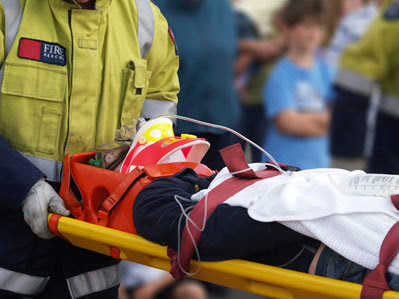The principles behind spinal immobilization, including the utilization of backboards and cervical collars was derived from expert opinion in the 1960’s [1-3], and has never been subjected to a randomized controlled trial or high quality observational study.
Significantly more patients are immobilized than will actually have a fracture [4], and whether or not immobilization actually improves outcomes for those who do have a fracture, is highly debatable.
Backboards should not be used once the patient reaches the Emergency Department (ED)
- Backboards have numerous well documented risks of harm:
- Increased field time for paramedics
- Pressure ulcers [5]
- Decreased tidal volumes [6,7]
- Increased pain
- Increases unnecessary imaging
- Professional organizations such as the American College of Emergency Physicians (ACEP) and the National Association of EMS Physicians (NAEMSP) support changing EMS practice to the selective use of backboards in the prehospital setting, and removal of patients from the backboard as soon as possible upon arrival to the emergency department.
- The mounting evidence [8,9] and expert opinions [10] lends credence to the idea that we should consider stopping the use of backboards in the ED, or to identify more appropriate alternatives.
Cervical Collars do not need to routinely be applied by EMS:
- Patients placed in full spinal immobilization after penetrating trauma have an increased risk of mortality, likely due to the increased time required at scene [11].
- One small study has suggested that paramedics can safely apply the Canadian C-Spine Rules (CCR), demonstrating a performance sensitivity of 100% and a specificity of 37.7% [12]. A larger, soon to be published study will prospectively confirm this in a larger population.
- Other selective immobilization strategies (ie: the NEXUS criteria) lack sufficient sensitivity to be recommended for the prehospital setting [13-15].
- Unconscious trauma patients are not included in the CCR, and are representative of a unique, high risk group.
Cervical Collars have never been shown to demonstrate any benefit:
- It appears likely that cervical collars may reduce neck movement, but all of the literature on this utilizes healthy volunteers or cadavers, neither of which is an appropriate representation of trauma patients [16].
- One retrospective study (with many limitations) found that patients with proven spinal fractures who had full spinal immobilization in place during transport actually had worse outcomes than patients who had no spinal immobilization during prehospital transport. This suggests that out of hospital immobilization has little to no effect on neurologic outcome [17].
- A longstanding dogma has suggested that immobilization is important to prevent secondary neurological worsening when a spinal fracture is present. However, there are very few cases of this reported in the literature, as this an extremely rare event, and possibly just a medical myth [18].
Cervical Collars are not as benign as you might think
- Cervical collars have many potential harms:
- Difficulty in airway management [19, 20] and increased potential for aspiration.
- Increased intracranial pressure [21].
- Risk of harm in patients with ankylosing spondylitis and a fracture [22, 23].
- Increased ICU complications [24].
- We are unable to exclude the possibility that these harms may outweigh any benefits to spinal immobilization, because there are no randomized trials looking at this question [25].
“Some spinal injuries are undoubtedly truly biomechanically and neurologically unstable and will benefit from immobilization. Others are probably biomechanically stable but fragile – these will suffer more neurological injury from delaying resuscitation.” – Mark Hauswald [17]
Bottom Line:
References


